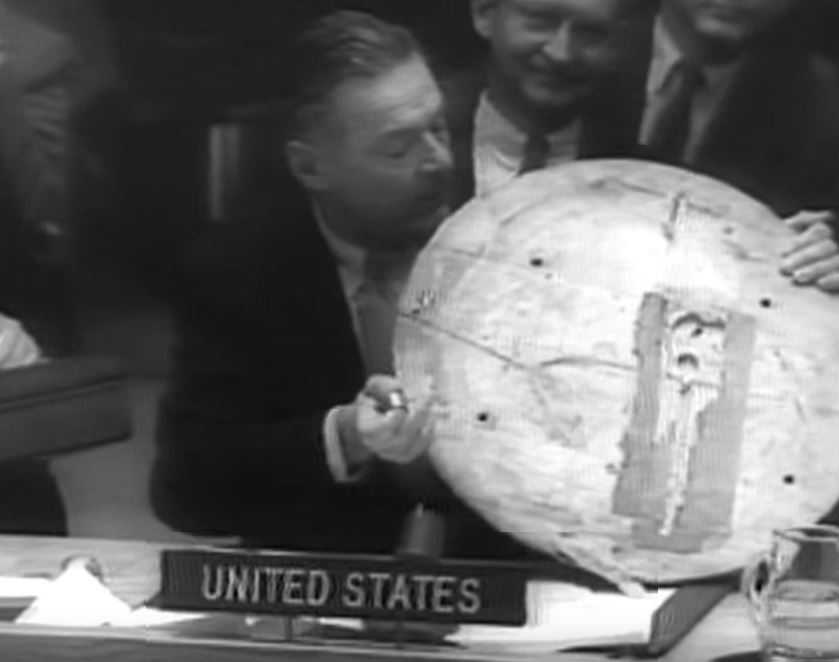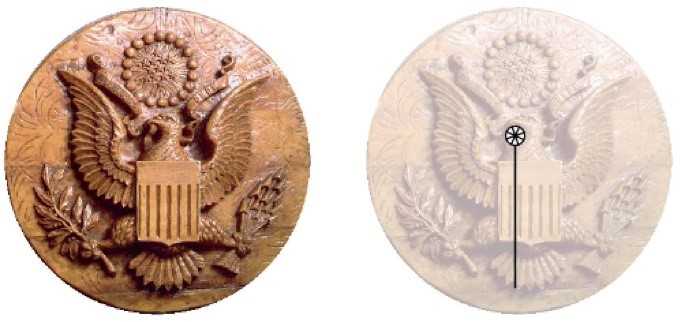60 years ago today, at a meeting of the United Nations Security Council (UNSC) and in front of a captivated global audience, U.S. Ambassador to the United Nations (UN) Henry Cabot Lodge, Jr. unveiled a shocking piece of Soviet subversion – one that confirmed for the public a spy vs. spy game that would come to define intelligence for the next three decades.
Ambassador Lodge explained to the other members that the United States had discovered a Soviet listening device planted in the office of the U.S. Ambassador to the Soviet Union’s residence in Moscow. In what can only be described as a late 1940s Trojan Horse, the listening device – commonly referred to as a ‘bug’ – was disguised in a wooden carving of the Great Seal of the United States and in 1945 was presented to then-U.S. Ambassador to the Soviet Union, W. Averell Harriman, as a gift to their one-time WWII ally.

The seal was hung in the office of the Ambassador’s residence, where it remained until its discovery in 1952.
It is difficult to determine exactly what and how much information may have been compromised in those six years, but one can assume that its placement in the Ambassador’s office afforded the Soviets access to a great deal of privileged information.
How it Worked
Though hidden listening devices were in their infancy in the late 1940s, they weren’t unheard of. No, what made this operation truly unique was the technology which allowed it to function undetected and without an external power source for years on-end.
The novel device is known as a passive repeater. It had no power source of its own, no batteries, and no wires which may have led to its discovery. Instead, the device would be ‘illuminated’ by a high frequency signal which would be beamed-in from a car parked outside of the Ambassador’s residence. Once illuminated, the device would be able to transmit sound waves detected in the room to an external receiver.

The clever design of this device gave it a potentially limitless operational lifespan and proved to be extremely difficult to detect. It wasn’t until a thorough technical surveillance sweep in 1952, during the Ambassadorship of George Kennan, that the device was discovered.
Political Leverage
Upon discovery of the listening device, the U.S. had a few options. The first – and perhaps the most tempting – was to broadcast Soviet deceit to the international community for an easy victory in the court of public opinion. The Truman (and later Eisenhower) Administration, however, recognized the opportunity they had been presented with and instead chose to withhold the discovery.
In addition to buying the U.S. time to research the device, the Truman Administration realized that the discovery could be used as political leverage in a tight spot. The decision would prove to be a valuable one.
Putting the Cards on the Table
For Mr. Lodge and the rest of the U.S. government, the announcement couldn’t have come at a more opportune time. Earlier that same month, on 1 May 1960, the Soviet Union had downed U-2 pilot Francis Gary Powers, Jr. who was conducting an aerial reconnaissance mission for the United States over Soviet territory. The Soviets had hoped, with this meeting of the UNSC, to denounce U.S. espionage activities related to the U-2 program and to show the world that the U.S. had been conducting unprovoked intelligence operations against the Soviet Union.

On the fourth day of meetings, on 26 May 1960 – and after three days of accusations from the Soviet Union – Representative Lodge presented his case to dramatic effect. He presented to the members and the cameras a wooden replica of the seal, explaining how the concealed device made its way into the Ambassador’s office and how it operated as a concealed listening device.
And while the declaration didn’t absolve the United States of the embarrassment of the U-2 incident, it did prove to the other members – and the rest of the world – that espionage activities were working in both directions. And as for the Soviet vote to censor the United States over the U-2 incident? The results were 7-2, in favor of the U.S.
